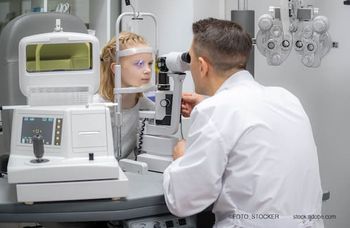
BLOG: Four reasons we miss MGD and how to do better
Alice Epitropoulos, MD, goes over meibomian gland dysfunction and the most common reasons it is missed in diagnosis and how to avoid them.
Functioning meibomian glands are essential for a healthy tear film. A normal eye has 45-70 meibomian glands, distributed along both lids. At any given time, less than half of those glands—and more on the nasal side than anywhere else—are actively yielding liquid secretions.1 Those secretions should be clear liquid, of an olive-oil-like consistency, that forms a shallow reservoir on the lid margin and is dragged across the tear film with each blink. The presence of healthy lipids in the tear film reduces evaporative water loss from the tears, supporting a healthy cornea and clear, comfortable vision.
Meibomian gland dysfunction (MGD) represents a breakdown of this system and is exceedingly common in older adults presenting for
Here are some of the reasons it gets overlooked:
It’s not obvious
Nonobvious MGD (NOMGD), a hyposecretory obstructive condition, without obvious signs of inflammation, is considered to be the most common form of MGD.5 It results in inadequate lipid for the formation of the lipid layer of tears, but doesn’t raise any red flags at the slit lamp.
Patients aren’t complaining
Particularly in the early stages of MGD, patients may not be symptomatic. But, as with any progressive disease, if we wait until the glands have atrophied and the patient is highly symptomatic, it may be too late for treatment to have much of an impact. The lack of symptoms does not mean the eye is healthy.
Doctors don’t express the glands
Expressing the meibomian glands on each eyelid is considered a primary assessment in the CEDARS dry eye algorithm.6 The ASCRS Cornea Committee dry eye algorithm similarly emphasizes that the clinical exam should follow a “look, lift, pull, push” pattern in which expressing the meibomian glands is a major element.7 With this simple step, the clinician can determine both meibum quality and expressibility.
It gets misdiagnosed
It is not uncommon for patients to have a combination of conditions—and ocular allergies are a major “co-conspirator.”The patient may be treating the allergies with antihistamines and other medications that can exacerbate evaporative dry eye.
The good news is that it is relatively simple to be more proactive in screening for and diagnosing MGD. All you really need to do is express the glands, stain the cornea, and evaluate the tear break-up time (TBUT). These 3 tests let you see whether the glands are functioning and how lipids might be affecting the tear film. Expression can be performed very quickly. While digital pressure or a cotton tip applicator are often used to observe meibomian gland expression, truly measuring function involves a more precise tool that can apply the same force as a deliberate blink, such as the inexpensive Korb meibomian gland evaluator.
Ideally, I would add a symptom questionnaire and meibography to evaluate the gland structure and to provide patients with clear, objective evidence of MGD. However, even without meibography, the simple 3-step process of express-stain-TBUT is enough to catch most patients with MGD and NOMGD.
Catching MGD earlier is important. We know it is a progressive disease that, untreated, will move from nonobvious and noninflammatory to visible gland obstruction, atrophy, and lid inflammation. Although my colleagues and I have shown that vectored thermal pulsation treatment (LipiFlow) can help to regenerate and reactivate the glands to some degree,8 achieving a fully restored structure and function after significant atrophy is unlikely. Starting treatment early, before structure and function are lost, is an optimal strategy.
Undiagnosed MGD can also have a negative effect on our cataract outcomes. There is a significant risk of inducing or undercorrecting astigmatism in patients with MGD.9 Preoperative meibomian gland loss is associated with postoperative discomfort and worsening TBUT, gland loss, and expressibility after cataract surgery.10 When these patients become more symptomatic after cataract surgery, they will think the surgery “caused” their dry eye, if you haven’t explained that it was there all along.
Time to start pressing on those lids more proactively. Try it—and see what you find.
References:
Tomlinson A, Bron AJ, Korb DR, et al. The international workshop on meibomian gland dysfunction: Report of the diagnosis subcommittee. Invest Ophthalmol Vis Sci 2011;52(4):
Yeu E, Koetting C, Calvelli H. Prevalence of meibomian gland atrophy in patients undergoing cataract surgery. Cornea 2023;Online ahead of print.
Jin X, Lin Z, Liu Y, et al. Hormone replacement therapy benefits meibomian gland dysfunction in perimenopausal women. Medicine (Balt) 2016;95(31):e4268.
Gupta PK, Stevens MN, Kashyap N, Priestley Y. Prevalence of meibomian gland atrophy in a pediatric population. Cornea 2018;37(4):426-30.
Blackie CA, Korb DR, Knop E, et al. Nonobvious obstructive meibomian gland dysfunction. Cornea 2010;29(12):1333-45.
Milner MS, Beckman KA, Luchs JI, et al. Dysfunctional tear syndrome: Dry eye disease and associated tear film disorders—new strategies for diagnosis and treatment. Curr Opin Ophthalmol 2017;28(Suppl 1):3-47.
Starr CE, Gupta PK, Farid M, et al; ASCRS Cornea Clinical Committee. An algorithm for the preoperative diagnosis and treatment of ocular surface disorders. J Cataract Refract Surg 2019;45:669-84.
Hura AS, Epitropoulos AT, Czyz CN, Rosenberg ED. Visible meibomian gland structure increases after vectored thermal pulsation treatment in dry eye disease patients with meibomian gland dysfunction. Clin Ophthalmol 2020;14:4287-96.
Matossian C. Impact of thermal pulsation treatment on astigmatism management and outcomes in meibomian gland dysfunction patients undergoing cataract surgery. Clin Ophthalmol 2020;14:2283-9.
El Ameen A, Majzoub S, Vandermeer G, Pisella P-J. Influence of cataract surgery on meibomian gland dysfunction. J Fr Ophthalmol 2018;41(5):e173-80.
Newsletter
Don’t miss out—get Ophthalmology Times updates on the latest clinical advancements and expert interviews, straight to your inbox.



















































.png)


